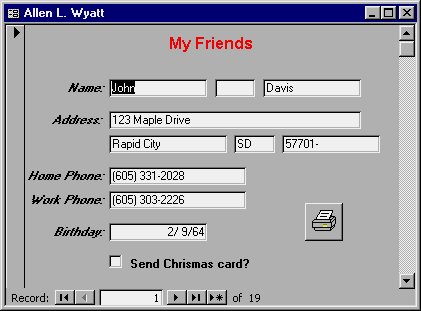Learn Access Now! Chapter 8 Next Section in Chapter 9 Chapter 10
Chapter 9: Creating Custom Forms
(This is section 1 of 4 in this chapter)
Throughout this book, you have entered and edited information in your tables. In this lesson, you will learn how to use Access forms for data input and editing. Forms let you go one giant step beyond regular data entry. In short, forms provide custom interfaces that let you work with data in the most natural way.
For example, if you are working with an employee database, you can create a form that matches an employee record. Depending on your company, you may have several different departments that use employee records. Using Access forms, you can create a custom interface for each department. Each department's form, in turn, will present only those fields that employees in that department need to use.
By the time you finish this chapter, you will understand the following key concepts:
- What Access forms are and their benefits
- Ways you create forms
- How you start and use the Forms Wizards
- How you create forms from scratch
- How you use the form design toolbox
- How you can use the Access color palette within your forms
- How to place objects on your form
- How properties apply to objects and forms
- How to save your form within your database
Understanding Forms
In Chapter 2, "Access in an Hour," you used the Datasheet to display the contents of a table. (Datasheets can also be used to present the results of a query, as you learned in Chapter 6, "Using Queries to Examine Your Data.") Using the Datasheet, you can enter and modify information easily. Unfortunately, Datasheets are not particularly user friendly. For example, in Chapter 4, "Creating Another Database," you developed a table to track your business customers. That table contains information about when your customers opened their accounts, what their credit limits are, and when they placed their last orders. It is not pertinent that everyone have access to this information.
That is where forms come in. You can create forms that display part (or all) of your table. In addition, a form can contain information designed to aid input, such as on-screen help, buttons, or custom tools. There are many benefits to using forms. For example, the form shown in Figure 9-1 is one you will create later in this chapter. Notice that the form is much more attractive and useful (from a user's perspective) than the Datasheet.

Figure 9-1 A sample form.
To use a form for input, all you need to do is select the Forms button in the Database window. If there are any forms available in your database, Access will list them. Select the form you want to use and then click your mouse on the Open button. You close a form in the same way you close any other window: you click your mouse on the Close icon in the upper-right corner of the form window.
Since forms are database objects, you can manipulate them in the same way that you manipulate other database objects such as tables, queries, and reports. This means you can use Access menu options to do things like copy, rename, and delete forms.
Learn Access Now! Chapter 8 Next Section in Chapter 9 Chapter 10